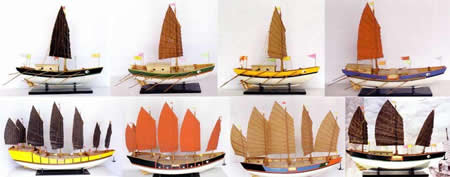Did monk from China “discover” Oregon 1,600 years ago?
Legend of a monk's journey to a land called “Fusang” dates back to 499 A.D.; is it possible that Fusang was Oregon? Or was the whole thing a complete fabrication?

A modern junk in the harbor at Hong Kong, as seen from the ninth floor
of City Hall
. This basic ship design dates
back nearly 2,000 years, and
an early example may actually have sailed
to Oregon in the fifth century
A.D. (Photo: Botaurus Stellaris)
By Finn J.D. John — March 13, 2011
Downloadable audio file (MP3)
There’s an ancient Chinese story about a monk named Hwui Shan who, at just about the same time the Roman Empire collapsed, set out on the open waters of the Pacific in search of new lands in which to spread his Buddhist faith.
According to this legend, after many months of sailing east, the monks made landfall in a strange place — a place that may actually have been Oregon.
Hwui Shan told his story in roughly the year 499, and either he or someone else wrote it down. According to this account, with other Buddhist monks, he had embarked in a junk — the standard Chinese sailing vessel of the day, invented about 200 years before — and sailed due east, into the rising sun. He estimated they’d sailed about 20,000 “li” (a Chinese unit of measurement) when they finally arrived at a place they called Fusang.
A legendary utopia called Fusang ...
Hwui Shan’s description of Fusang reads a bit like an early version of a vision of Utopia — a good argument for being a bit skeptical. The people in Fusang, he relates, have a particular tree or plant (the “Fusang tree”) that supplies their every need: they eat its sprouts like bamboo shoots; it bears red pear-shaped fruits that keep for an entire year in cool storage; and its bark supplies fiber that’s woven into clothing and made into paper. And yes, the society he describes is literate, with its own system of writing.
The holy man goes on to describe the sociology of the place: “The people have no weapons, and make no war,” he recounts (as translated by Charles Leland in 1875). “No iron is found in this land; but copper, gold and silver are not prized, and do not serve as a medium of exchange in the market.”
... a utopia for some of them, anyway.
Also, there are two prisons, a northerly one and a southerly one — maximum and minimum security, respectively. In the northerly prison, “those men and women who were imprisoned for life were allowed to marry,” the account goes. “The boys resulting from these marriages were, at the age of eight years, sold as slaves; the girls, not until their ninth year.”

Two junks – the Sin Tong Hong and the Tek Hwa Seng – in the Dutch
East Indies in 1936. The basic design of the junk dates from the third
century A.D., and this was almost certainly the type of ship used by
Hwui Shan’s monks. (Photo: Tropenmuseum of the Royal Tropical
Institute, Amsterdam)
The people of Fusang have most of the livestock known in China, but use them somewhat differently, according to the report: “Stags are used here as cattle are used in the Middle Kingdom, and from the milk of the hind they make butter.”
Also, the horns of the oxen are “so large that they hold ten bushels,” Hwui Shan’s account adds. “They use them to contain all manner of things.”
After this rather fantastic account of Fusang, the monk goes on to describe another land he visited — a land of pale women with very hairy bodies who have no breasts, but rather suckle their children on particularly long clumps of hair. There are no men in this place; when they want to become pregnant, the women bathe in a magic river.
Certainly it’s impossible to buy Hwui Shan’s story at face value — especially after reading his account of the land of women, in which he rather jumps the shark, as the saying goes. And the myth of the faraway people who know nothing of violence and strife is almost a universal human cliché. But this story is 1,600 years old. Is there any possibility it’s based, at least in part, on truth? Could a Chinese sailing vessel have made it to the Oregon coast — or anyplace else on the continent — and made it back home again?
Believable? No. Possible? Actually, yes.
Sailing to Oregon from China is certainly possible, given a little luck and the right kind of weather. Every year, hundreds of glass fishing floats make it across the Pacific, courtesy of a current that runs this way from the sea off Japan. And in fact, in 1833 a Japanese sailing ship wrecked at Cape Flattery on what's now the Washington coast (at the time it was part of the Oregon Territory), and three of its sailors were rescued by the British and taken to Fort Vancouver; they ended up going home via Europe, completely circumnavigating the globe in the process.

These model junks are among a large number on display in Antwerp, part of a
Belgian Royal collection left behind by the Chinese exhibitors at the Exposition
Universelle de Bruxelles, in Belgium in 1910. Numerous others can be seen on
www.lazloart.com; to see them, click here.
Sailing back to China to tell the tale would be trickier. The prevailing winds off Oregon and Washington come out of the southwest — great for coming this way, but not so hot for going back. But if the monks moved down the coast to Mexico before disembarking, they would find the wind situation reversed. It is theoretically possible.
Is there a kernel of truth in this legend?
The story of Hwui Shan’s adventures reads a little like Homer’s Odyssey. And like The Odyssey, there’s probably a kernel of true history in it somewhere — buried deep beneath centuries of distortions and additions from thousands of scribes and storytellers through the years.
If all the fantasy could be stripped away — if we could somehow forensically reconstruct the real story of Hwui Shan and his fellow monks — there is an actual possibility that we would be crediting him, not Christopher Columbus or Leif Ericson, with the “discovery” of the Americas in general — and of Oregon in particular.
(Sources: Leland, Charles. Fusang, or The Discovery of America by Chinese Buddhist Priests in the Fifth Century. London: Trubner & Co., 1875; Long, James Andrew. Oregon Firsts, Past and Present. North Plains, Ore: Oregon Firsts Media, 1994)
TAGS: #Fusang #HwuiShan #ChineseJunk #Utopians #BuddhistMonks #Evangelism #CharlesLeland #JamesAndrewLong











